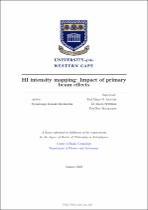| dc.contributor.advisor | Santos, Mario G. | |
| dc.contributor.author | Matshawule, Siyambonga Donald | |
| dc.date.accessioned | 2023-02-01T08:29:25Z | |
| dc.date.available | 2023-02-01T08:29:25Z | |
| dc.date.issued | 2023 | |
| dc.identifier.uri | http://hdl.handle.net/11394/9531 | |
| dc.description | Philosophiae Doctor - PhD | en_US |
| dc.description.abstract | Neutral hydrogen (HI) intensity mapping surveys with upcoming and future radio telescopes
such as the MeerKAT, a precursor to the Square Kilometre Array Observatory
(SKAO) MID telescope, have great potential for constraining cosmology, particularly in
the post-reionization Universe provided that e ective cleaning methods are available to
separate the strong foregrounds from the cosmological signal. The application of cleaning
methods is usually conducted under the assumption of simplistic primary beam models.
In this thesis, I simulate a single-dish wide-area survey with MeerKAT characteristics, and
test foreground subtraction with a realistic model for the primary beam that contains a
non-trivial frequency dependence. I also probe the impact of strong point sources on
the cleaning. To conduct this evaluation, point source maps from a much more realistic
full-sky point source catalogue are included as part of the foregrounds present in the sky
model. | en_US |
| dc.language.iso | en | en_US |
| dc.publisher | University of the Western Cape | en_US |
| dc.subject | Astronomy | en_US |
| dc.subject | Physics | en_US |
| dc.subject | Cosmology | en_US |
| dc.subject | Neutral hydrogen | en_US |
| dc.title | HI intensity mapping: Impact of primary beam effects | en_US |
| dc.rights.holder | University of the Western Cape | en_US |

